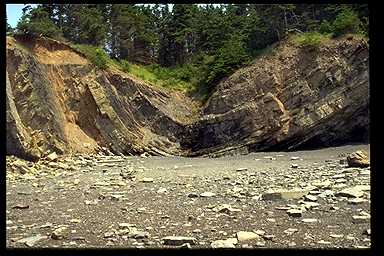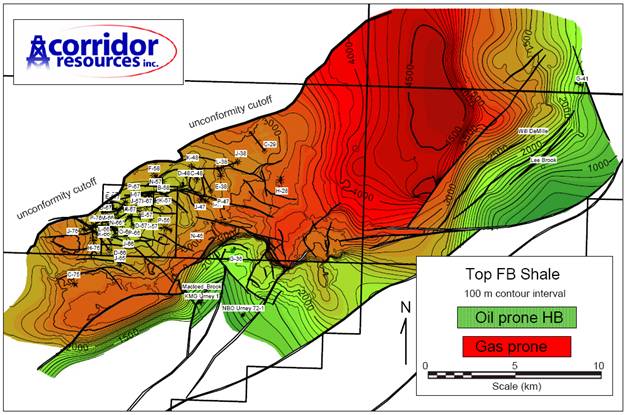Graduate Research Projects
This listing includes both current and potential future research projects dealing with deformed sedimentary rocks in Canadian orogens. For further details contact John Waldron (email: john.waldron "at" ualberta.ca)
- Current and recently graduated students shown in italics.
Development of the Late Paleozoic Maritimes Sedimentary Basin, Atlantic Canada
The Maritimes sedimentary basin is a huge sedimentary basin (more than 400 km in diameter and at least 12 km deep) that developed late in the history of the Appalachian orogen in Atlantic Canada, during Devonian to Permian time. An extensive database of seismic reflection profiles and a relatively small number of wells give information about the subsurface. On-land portions of the basin show evidence of deformation due to both transpression and transtension. In addition, the structural geometry in parts of the basin has been strongly modified by evaporite flow. This program of research incorporates several sub-projects using diverse datasets (seismic profiles, wells, field mapping) to produce a viable model for the subsidence mechanism and history of the basin. Projects include:
- Stratigraphic and structural development of the Horton Group, Windsor-Kennetcook basin, Nova Scotia. The Windsor-Kennetcook, located in southern mainland Nova Scotia, contains deep sedimentary basins filled with clastic sedimentary rocks of the Horton Group, overlain by carbonates and evaporites of the Windsor Group, and transported rocks of the Kennetcook thrust system. Recent drilling and the aquisition of seismic reflection profiles allows an in-depth evaluation of the stratigraphy, previously only known from partial sections along the coast. Interest in the Horton Group for both conventional hydrocarbons and shale gas makes an investigation of the fractures and fabrics of particular interest. Two projects are planned, at MSc level.

- Stratigraphy and sedimentology of the Horton Group - outcrop to subsurface correlation in the Windsor-Kennetcook basin. The Horton Group has traditionally been divided into two units - the lower Horton Bluff Formation, generally interpreted as mainly lacustrine, overlain by the Cheverie Formation, generally interpreted as fluvial. The two units record environmental change as Nova Scotia drifted toward the equator in Mississippian time.
- Fracture and fabric development in the Windsor-Kennetcook basin. This project will examine the spectuacular coastal exposures of the Horton Group from both the footwall and hanging wall of the Kennetcook thrust system, including joints and fractures, normal, thrust and strike-slip faults, and the early stages of cleavage development.
- Map-scale structure of the Kennetcook-Windsor basin; K.H. Javaid M.Sc. in progress.
- Fault development and the role of strike-slip deformation in the McCully area of southern New Brunswick
- In collaboration with Corridor Resources Inc. we are seeking a student to undertake an analysis of fault development in an evolving strike-slip or transtensional basin.

- Applications are invited from students interested in undertaking research at the M.Sc. level who have experience with seismic reflection data and a strong interest in structural geology. Applications from students eligible for support under the NSERC Industrial Postgraduate Scholarships Program are especially encouraged.
- Deformation and development of the Bay St. George basin, SW Newfoundland
- Major strike-slip faults in the Maritimes Basin: restoring the pre-Carboniferous geometry of the Appalachian orogen (with S.M. Barr, Acadia Univ., C.E. White, N.S.D.N.R.)
- Development of the Windsor-Kennetcook basin, Nova Scotia (C.Roselli, MSc completed; K.M. Javaid MSc in progress)
- Role of evaporites in development of the Cumberland basin (with M. Rygel, State University of New York, Potsdam)
Terrane evolution in the Early Paleozoic Appalachian-Caledonide orogen
Detrital zircon grains occur in many sandstones from which they can be extracted and rapidly dated using the laser-ablation multicollector inductively coupled plasma mass-spectrometer (LA-ICP-MS) at the University of Alberta. In contrast to most dating projects in igneous rocks, the object is not to determine the age of the rocks in which the zircons are found. Instead, we sample sandstones of known age from sedimentary basins, and use the detrital zircons to determine the ages of crustal units that were undergoing erosion and contributing detritus to the basin at that time. In this program, we will examine detrital zircon populations from Early Paleozoic sandstones in terranes of poorly known affinities in the Appalachians, such as Ganderia and Meguma, with the aim of locating those terranes in relation to the Iapetus and Rheic oceans.
In addition, the foreland basin of the Appalachians in Atlantic Canada though largely concealed beneath the Gulf of St. Lawrence, is extensively imaged in offshore and onshore seismic data. We will correlate the offshore and onshore data and investigate the history of the orogen as recorded in this basin, using a combination of seismic and provenance data.
- Onset of arc-continent collision in the Newfoundland Appalachians: twin records of sediment composition and soft-sediment deformation in the Humber Arm Allochthon
- Dating terrane collison: tracking the arrival of Laurentian detrital zircon British Avalonia
- Meguma Terrane and the Harlech Dome of North Wales: - exploring the correlation of two widely separated but similar terranes (H. Pothier M.Sc. in progress)
- Detrital zircon history and terrane interactions of Ganderia: - UK, Ireland, and Atlantic Canada
- Development of the Appalachian foreland basin and thrust front, western Newfoundland and Gulf of St. Lawrence (S.E.White in progress)
- Accretion history and provenance of the Southern Uplands terrane and its equivalents (with J. Floyd, BGS, and others)
Deformation processes in the Canadian Cordillera
The Canadian Cordillera provides superb opportunities to study processes of deformation in sedimentary rocks. In the foothills belt, folds and faults are intimately related. Significant controversies have surrounded the timing and relationships of faults and folds. In the Blairmore area a tight fold fits models of fault propagation folding, but the structure is modified by at least one lateral ramp, that produces changes in the plunge of the fold. The structure is an exceptionally well exposed example of a fold associated with loss of displacement on a thrust, and, from a practical point of view, it is an exposed analogue of petroleum-producing structures in the subsurface. Farther west, the McConnel thrust brings to surface exposure structures closely similar to those present in the subsurface of the foothills where they form important reservoirs for oil and natural gas. These projects examine structures exposed at the thrust front and compare them with those found in the subsurface, using a combination of outcrop and seismic data. In addition, the front ranges provide opportunities to study the flow of fluids and their role in dolomitization of carbonate rocks. Farther into the Cordillera, rocks from the early history of the Laurentian continental margin are exposed in the Cariboo Mountains, where they provide a natural laboratory for the study of ancient slope processes; work in this area is focussed upon distinguishing the various effects of soft-sediment and hard-rock deformation.
- Deformation at McConnel thrust: Rocky Mountain Front Ranges, Black Rock Mountain, AB
- Structural geometry and its relationship to dolomitization, Canadian Rocky Mountains. In collaboration with Dr. Hans Machel. Details can be found at http://easweb.eas.ualberta.ca/graduates/opportunities/gradopp.cfm
- Geometry and kinematics of a fault-related folds, Bluff Mountain/Turtle Mountain, AB. (S.E.Hartman M.Sc. in progress).
- Deformation and its effect on sedimentary structures: Windermere Supergroup, Canadian Cordillera (K. Wallace M.Sc. in progress)
- Quantifying and developing centre-to-centre (Fry) methods of strain determination
- Initiation and deformation of a sedimentary basin on a Cordilleran arc terrane: Hazelton Trough - Bowser Basin (W. Loogman M.Sc., J.-F. Gagnon Ph.D. completed)


